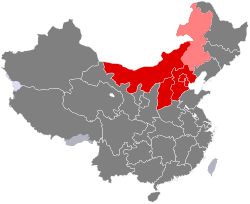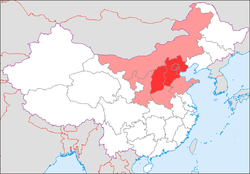North China
North China (simplified Chinese: 华北; traditional Chinese: 華北; pinyin: Huáběi; literally "China's north") is a geographical region of China, consisting of the provinces of Beijing, Tianjin, Hebei, Shanxi and Inner Mongolia. It lies north of the Qinling Huaihe Line[1], with its heartland in the North China Plain.
North China | |
|---|---|
 Northern People's Republic of China region | |
| Area | |
| • Total | 2,185,105 km2 (843,674 sq mi) |
| Population | |
| • Total | 164,823,136 |
| • Density | 75/km2 (200/sq mi) |

In modern times, the area has shifted in terms of socio-political and economic composition. Nowadays unique, embracing a North Chinese culture, it is influenced by Marxism, Soviet systems of industry while preserving a traditional Chinese indigenous culture. The region has been cultivating wheat, and most inhabitants here speak variants of Northern Chinese languages such as the standard (Mandarin), which includes Beijing dialect, which is largely the basis of Standard Chinese (Mandarin), the official language of the People's Republic of China (PRC), and its cousin variants. Jin Chinese and Mongolian are also widely spoken due to the political and cultural history of the area.
History
In prehistory, the region was home to the Yangshao and Longshan cultures. Peking man was found near modern-day Beijing (Peking).
Administrative divisions in the PRC
| GB[2] | ISO №[3] | Province | Chinese Name | Capital | Population¹ | Density² | Area³ | Abbreviation/Symbol |
|---|---|---|---|---|---|---|---|---|
| BJ | 11 | Beijing Municipality | 北京市 Běijīng Shì |
Beijing | 19,612,368 | 1,167.40 | 16,800 | 京 Jīng |
| TJ | 12 | Tianjin Municipality | 天津市 Tiānjīn Shì |
Tianjin | 12,938,224 | 1,144.46 | 11,305 | 津 Jīn |
| HE | 13 | Hebei Province | 河北省 Héběi Shěng |
Shijiazhuang | 71,854,202 | 382.81 | 187,700 | 冀 Jì |
| SX | 14 | Shanxi Province | 山西省 Shānxī Shěng |
Taiyuan | 35,712,111 | 228.48 | 156,300 | 晋 Jìn |
| NM | 15 | Inner Mongolia Autonomous Region Nei Mongol Autonomous Region |
內蒙古自治区 Nèi Měnggǔ Zìzhìqū |
Hohhot | 24,706,321 | 20.88 | 1,183,000 | 蒙(內蒙古) Měng (Nèi Měnggǔ) |
Cities with urban area over one million in population
- Provincial capitals in bold.
| # | City | Urban area[4] | District area[4] | City proper[4] | Prov. | Census date |
|---|---|---|---|---|---|---|
| 1 | Beijing | 16,446,857 | 18,827,262 | 19,612,368 | BJ | 2010-11-01 |
| 2 | Tianjin | 9,562,255 | 11,090,783 | 12,938,693 | TJ | 2010-11-01 |
| 3 | Taiyuan | 3,154,157 | 3,426,519 | 4,201,592 | SX | 2010-11-01 |
| 4 | Shijiazhuang | 2,770,344 | 2,834,942 | 10,163,788 | HE | 2010-11-01 |
| 5 | Tangshan | 2,128,191 | 3,187,171 | 7,577,289 | HE | 2010-11-01 |
| 6 | Baotou | 1,900,373 | 2,096,851 | 2,650,364 | NM | 2010-11-01 |
| 7 | Hohhot | 1,497,110 | 1,980,774 | 2,866,615 | NM | 2010-11-01 |
| 8 | Datong | 1,362,314 | 1,737,514 | 3,318,054 | SX | 2010-11-01 |
| 9 | Handan | 1,316,674 | 1,445,338 | 9,174,683 | HE | 2010-11-01 |
| 10 | Baoding | 1,038,195 | 1,138,521 | 11,194,382 | HE | 2010-11-01 |
References
- Li, Shuangshuang; Yang, Saini; LIU, Xianfeng (10 September 2015). "Spatiotemporal variability of extreme precipitation in north and south of the Qinling-Huaihe region and influencing factors during 1960-2013". The Chinese journal of geography. 34 (3): 354–363. Retrieved 25 May 2017.
- GB/T 2260 codes for the provinces of China
- ISO 3166-2:CN (ISO 3166-2 codes for the provinces of China)
- 国务院人口普查办公室; 国家统计局人口和社会科技统计司, eds. (2012). 中国2010年人口普查分县资料. Beijing: China Statistics Press. ISBN 978-7-5037-6659-6.